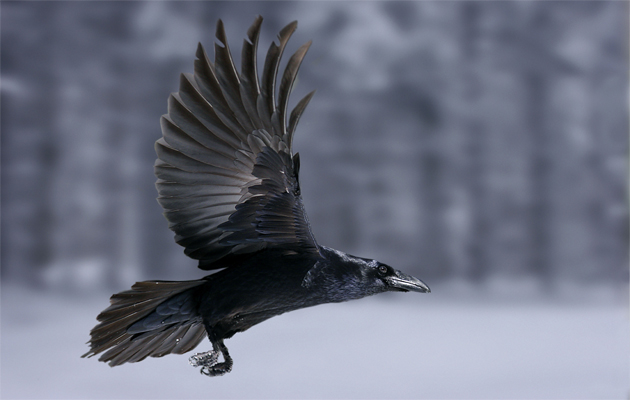The Raven: ruler of the crow clan
We look at the compellingly majestic raven.


We shall begin the year with an ‘unkindness’ that rarely needed collective noun for the common raven. Majestic, ominous, rapacious and sagacious, with a coat the colour of night, perhaps no bird worldwide is so impressively freighted with lore as Corvus corax, the supreme member of the crow tribe.
Variously known as croupy craw, corbie or just Ralph, he sports a shaggy throat, boasts a wingspan of 4ft and, from his formidable bill to his ‘crowbar’ legs, he appears glistening black (apart from two brown irises). However, this sombre uniformity is misleading, for, in good light, the plumage is shot through with an iridescent purplish green.
Widely distributed from coastal Greenland to the Hindu Kush, the raven was, indeed, once common. Until Restoration times, it was actually protected as a scavenger useful in cleaning our foul streets; thereafter, it lost this immunity and was regarded as a threat to livestock. With the improvement in firearms, it was harried by herdsmen and preservers of game, becoming an outcast amongst the crags, tors and sea cliffs of remoter Britain.
Ever alert, it has learned to be leery of humankind. Unless you visit one of the pampered creatures in the Tower of London, these days, you must seek them in the wilderness, languidly gliding on pointed wings, their primaries splayed like fingers.
Technically our largest songbird, the raven has a voice that’s unmistakable, if not exactly musical. The short, trademark double quork is but one of a range of acoustic signals (once said to number 64 in all) and its vocal repertoire includes gurgles, rattles and clicking. Its powers of mimicry are renowned. Poe’s ebony bird repeated ‘nevermore’ and a Roman specimen that greeted Emperor Tiberius by name every morning was eventually granted a public funeral. Near one picnic site, ravens have taken to imitating the flushing sounds of a public urinal.
Least social of all the corvids, Ralph possesses an especially heavy brain and is deemed as intelligent as any bird. He is resourceful apparently improvising the use of tools can communicate the whereabouts of food sources and seems to have playful tendencies. As pets, ravens invariably prove mischievous Dickens kept several (one, Grip, features in Barnaby Rudge) and Nobel Laureate Konrad Lorenz had Roa, who liked stealing ladies’ underwear from clotheslines.
Generally monogamous the chances of cheating are, anyway, quite rare up amid the Bens ravens stay paired all year and nesting begins in February, before winter is even over. Male courtship displays involve elaborate aerobatics, the proffering of titbits and, unusually, the raising of feathery eyebrows.
Sign up for the Country Life Newsletter
Exquisite houses, the beauty of Nature, and how to get the most from your life, straight to your inbox.
The nest itself is massively constructed of sticks and wool, although materials from antlers to barbed wire have been recorded. A single clutch is laid—the eggs, rather on the small side for such a mighty bird, are greenish grey, but oologists particularly prized a pink variant.
There persists a myth that they’re bad parents: the ancient term unkyndenes referred to their supposed refusal to feed nestlings until they fledged, leaving them to subsist on ‘the dew from heaven’. In practice, ravens are fiercely protective of their young.
An opportunistic omnivore, the ‘sable butcher’ will happily guzzle anything from a pizza to a puffin. Its gargantuan bill of fare embraces eggs, fruit, small mammals, roadkill and animal faeces. Largely a carrion feeder, it has an unsavoury reputation for attacking hill sheep. It does stab at soft targets (such as the tongue or eyes), but the beak can’t actually break open a carcass.
In America, ravens frequently hunt in tandem with wolves or bears. Over here, it’s believed they lead stalkers to deer, in the expectation of a tasty gralloch. They are uncannily quick to locate corpses perhaps that’s why Noah sent one out across the floodplain and historically are associated with places of execution (‘raven stones’) and battlefields. The Vikings depicted a raven on their banners (it was sacred to Odin). Down the ages, it has become par excellence the Bird of Death.
Identified in many cultures as a trickster figure and a creature of uncanny wisdom, the raven is also revered for its longevity and powers of survival. In Christian iconography, it’s linked with Elijah, who, on the run from Ahab, was daily fed by the birds (in Victorian taverns, a raven was, accordingly, a small portion of bread and cheese), and the Saints Benedict and Oswald, who similarly benefited from their ministrations.
In pagan circles, it was a bird of ill luck, a croaking portent of disaster. The Romans consulted it for divination—the cry cras was held to be a reminder of the morrow—and it was integral to the secretive, military cult of Mithras. Pliny the Unreliable reckoned that, if a pregnant woman consumed a raven’s egg, she would give birth via her mouth. Martial, inevitably, composed an obscene poem on the subject.
The Inuit dine off tulukar with relish, despite its gruesome diet. Most folk never would, even if ravenous.
Country Life is unlike any other magazine: the only glossy weekly on the newsstand and the only magazine that has been guest-edited by HRH The King not once, but twice. It is a celebration of modern rural life and all its diverse joys and pleasures — that was first published in Queen Victoria's Diamond Jubilee year. Our eclectic mixture of witty and informative content — from the most up-to-date property news and commentary and a coveted glimpse inside some of the UK's best houses and gardens, to gardening, the arts and interior design, written by experts in their field — still cannot be found in print or online, anywhere else.
-
 Seven of the UK’s best Arts and Crafts buildings — and you can stay in all of them
Seven of the UK’s best Arts and Crafts buildings — and you can stay in all of themThe Arts and Crafts movement was an international design trend with roots in the UK — and lots of buildings built and decorated in the style have since been turned into hotels.
By Ben West
-
 A Grecian masterpiece that might be one of the nation's finest homes comes up for sale in Kent
A Grecian masterpiece that might be one of the nation's finest homes comes up for sale in KentGrade I-listed Holwood House sits in 40 acres of private parkland just 15 miles from central London. It is spectacular.
By Penny Churchill